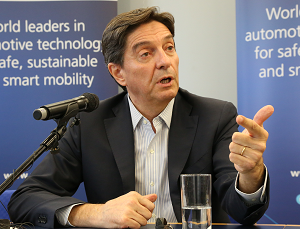QUESTIONS
1. Could you briefly introduce CLEPA to our audience? What are CLEPA’s recent studies and
projects?
 CLEPA is the European Association of Automotive Suppliers. We have over 120 corporate members and over 20 Trade associations and associated members. CLEPA is the voice of the EU automotive supplier’s industry linking the sector to the policymakers. We engage in areas such governmental relations, trade, aftermarket and research and innovation. Our vision is for the European Automotive Suppliers industry to be the leading provider of sustainable mobility worldwide. We want to increase the competitiveness of the industry, drive sustainable growth and enhance wealth and employment.
CLEPA is the European Association of Automotive Suppliers. We have over 120 corporate members and over 20 Trade associations and associated members. CLEPA is the voice of the EU automotive supplier’s industry linking the sector to the policymakers. We engage in areas such governmental relations, trade, aftermarket and research and innovation. Our vision is for the European Automotive Suppliers industry to be the leading provider of sustainable mobility worldwide. We want to increase the competitiveness of the industry, drive sustainable growth and enhance wealth and employment.
Facts:
- An average car is made up of 30.000 parts.
- Up to 75% of a vehicle's value is produced by the suppliers.
- The automotive industry files around 3000 patents each year and CLEPA members are world leaders on this front
- CLEPA represents 5 million direct jobs and trade worth 75 billion a year.
2. Could you share some information about your current committees? What kinds of studies are
executed by CLEPA committees due to current developments in the market?
The CLEPA Aftermarket Forum has recently overseen a publication of a report by Mckinsey on the automotive aftermarket business. Mc Kinsey expects the market to grow globally by 3% per annum by 2030. The aftermarket is continued to be seen as an important pillar of the entire automotive business with increasing relevance in Asia, especially China, as the main driver for growth. Beside an outlook on the future portfolio and geographical differences, the study looks at economic and technological trends with the potential to disrupt the automotive aftermarket over the next 5 to 10 years. The McKinsey study shows how market players will face challenges from the increasing pace of industry consolidation, especially in North-America and Europe. In addition, many players have conducted business over decades in a relatively stable environment will face a new type of competitive pressure from players at different stages of the aftermarket value chain as well as from new players offering digital-driven business models.
4. Also, we would like to discover the new trends in the automotive industry covering market details,
innovation and R&D developments. Could you share your opinions on this issue?
 Today is an exciting time to be a part of the automotive industry, even though the demands of the business have never been greater. An annual investment of 20b is made in R&D each yearn and this will need to be continue. There are two main trends currently affecting the automotive industry: digitisation and decarbonisation are fundamentally changing the way our industry is powered and our economy is designed.
Today is an exciting time to be a part of the automotive industry, even though the demands of the business have never been greater. An annual investment of 20b is made in R&D each yearn and this will need to be continue. There are two main trends currently affecting the automotive industry: digitisation and decarbonisation are fundamentally changing the way our industry is powered and our economy is designed.
Consider, as anexample, the car’s interior: until recently a relatively stable component in terms of engineering and value to the automobile. Now, interior surfaces offer potential space for ambitious enhancements of safety or entertainment. New technologies such as 3D laminated glass, haptic sensors, and augmented reality heads-up displays — which offer drivers alerts, safety aids, and warnings on invisible screens embedded in the windshield — have entered the vocabulary of traditional suppliers. Large navigation and entertainment display screens in the dashboard offer Web-based information and media, as well as data arrays, picked up from networked roads and other cars. The autonomous car will further change this situation. Traditional business models and value chains are changing.
Taken as a whole, innovation-related challenges are reshaping traditional auto industry structures and relationships — in particular, by impending the existing distribution of revenues and the boundaries between OEMs and Tier One or Tier Two suppliers, as well as between automotive and tech companies. Some suppliers will thrive and others will be challenged because changes in technology content will bring OEMs or non-automotive suppliers into their markets as new competitors. Decisions about investments and industry alliances that are being made now will determine the dominant positions of tomorrow.
5. What kind of developments do you expect in the automotive technologies in the next 10 years?
What do you think will be the future technologies and which ones will stand out?
Connected and automated driving allows for significant benefits in terms of fuel and emission reduction. Vehicles will be able to communicate with each other and with local road infrastructure resulting in fewer traffic jams and facilitating to decarbonisation.
CLEPA members are technology solutions providers. The next 10 years in car tech will make the last 30 look like just a warm-up. Further along the foggy path of time, it’s clear that autonomous driving will be a part of our automotive existence. We have seen grand demonstrations at this year’s IAA motor show in Frankfurt.
In five years, the very idea of a car without a built-in internet connection should be as awkward as buying a phone without Wi-Fi today. By 2021, the first production self-driving vehicle is expected to be for sale. Car companies and suppliers need to figure out the kinds of services that consumers will be willing to pay for and deliver platforms and architectures that can enable them.
6. Could you tell us what you think about e-mobility? How do you think it will affect the sector?
In 2030, the share of electrified vehicles could range from 10 percent to 50 percent of new-vehicle sales. Adoption rates will be highest in developed dense cities with strict emission regulations and consumer incentives (tax breaks, special parking and driving privileges). Sales penetration will be slower in small towns and rural areas with lower levels of charging infrastructure and higher dependency on driving range.
Through continuous improvements in battery technology and cost, electrified vehicles are expected to gain more and more market share from conventional vehicles. Electrified vehicles will achieve cost competitiveness with conventional vehicles, creating the most significant catalyst for market penetration. At the same time, it is important to note that electrified vehicles include a large portion of hybrid electrics, which means that also beyond 2030, the internal-combustion engine will remain very relevant.
- CLEPA’s recent position papers on post-2020 C02 emission reduction targets and HDV CO2 reduction.
7. Could you evaluate zero emission oriented action plans and strategies of the manufacturers of
the sector in general?
Low-emission mobility is an essential component of the broader shift to the low-carbon,circular economy needed for Europe to stay competitive and be able to cater to the mobility needs of people and goods. Transport has much greater potential than in the past to contribute towards reducing the EU's emissions, as we have committed to do under the Paris Agreement on climate change and in line with the 2030 Agenda on Sustainable Development.
The shift towards low-emission mobility has already started globally and its pace is accelerating. It offers major opportunities. It is an opportunity for European car manufacturers to embrace new technologies more strongly and regain the trust of consumers. It is also an opportunity for innovative energy companies and service providers, as well as for investors to contribute to sustainable growth and provide new jobs. Through its initiatives, the EU will create enabling conditions and provide strong incentives for low-emission mobility. The actions announced by the EU must be part of a holistic approach requiring the long-term engagement of all stakeholders, including the Member States, which will have to do their part according to their responsibilities.
This strategy for low-emission mobility should make an important contribution to modernising the EU economy, helping to reduce emissions from the transport sector and meeting the EU's commitments under the Paris Agreement.
9. What do you think about Turkish automotive industry? What is the importance and role of
Turkish automotive industry in the world?
With a cluster of car-makers and parts suppliers, the Turkish automotive sector has become an integral part of the global network of production bases, export-oriented and open to growth and development. Turkish suppliers make up a strong network that is experienced in international collaboration, and flexible in terms of meeting the requirement of different quality systems. I refer to Alper Kanca, the Chairman of Association of Automotive Parts & Components Manufacturers (TAYSAD), who has said that the rise in Turkish automotive industry continued and Turkish industry had shown its power to the whole world by increasing its domestic and international operations.